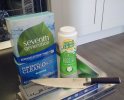Can you maintain kitchen knives as effectively with a strop as with a steel?
Background: My family members do most of the food prep and are not into sharpening, so after I sharpen the kitchen blades, I want to give them an easy, simple way to maintain those knives when I'm not around. We currently have a high grit ceramic steel, but they are having trouble using it effectively. I could get them an angle guide for the steel. Or I could get them a small hard strop block and they could just do a few strop passes at a low angle, which is probably easier than using a steel.
Background: My family members do most of the food prep and are not into sharpening, so after I sharpen the kitchen blades, I want to give them an easy, simple way to maintain those knives when I'm not around. We currently have a high grit ceramic steel, but they are having trouble using it effectively. I could get them an angle guide for the steel. Or I could get them a small hard strop block and they could just do a few strop passes at a low angle, which is probably easier than using a steel.

